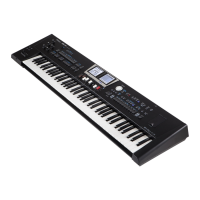MIDI
151
Preset
1. Flat 4. Jazz 7. User
2. Rock 5. Classic
3. Pop 6. Standard
5. If none of the preset memories contains the settings you
need, use the dial to set the following parameters:
Parameter Setting Explanation
Level 0~127
Use this parameter to set the equalizer’s
input level. This may be necessary when
the level of the input signals is so high
that the sound distorts.
NOTE
Do not set this parameter to “0” if the
equalizer is switched on, because
doing so means that the keyboard
parts, SMF song/rhythm is/are no
longer audible.
Gain –9~0~+9 dB
Use this parameter to correct the
level at the equalizer’s outputs. If the
settings of the remaining parameters
lead to a signicantly lower level, select
a positive value. If your settings lead
to a signicantly higher level, select a
negative value. “0” means that the level is
neither boosted nor attenuated.
High
Frequency
2000~12000 Hz
Allows you to set the cuto frequency of
the high band (this is a shelving lter).
High Gain –15~+15 dB
Use this parameter to set the level of
the selected “High” frequency. Positive
values boost (increase the volume of)
that frequency band, negative values cut
(attenuate) it.
Mid Frequency 200~8000 Hz
Allows you to set the cuto frequency of
the middle band (this is a peaking lter).
Mid Q
0.5, 1.0, 2.0,
4.0, 8.0
Use this parameter to specify the width
of the “Mid Frequency” band that you
want to boost or cut. Smaller values
mean that neighboring frequencies
above/below that value are also aected.
Mid Gain –15~+15 dB
Use this parameter to set the level of the
selected “Mid” frequency.
Low Frequency
50, 80, 100,
150, 200, 250,
300, 400 Hz
Allows you to set the cuto frequency of
the low band (this is a shelving lter).
Low Gain –15~+15 dB
Use this parameter to set the level of the
selected “Low” frequency.
Write the “User” Equalizer
This function allows you to save the settings you made on the “SMF/
Rhythm Equalizer” or “Tone Parts Equalizer” page.
1. Press the [WRITE] button.
Right Display
2. Rotate the dial to select “YES”, then push it to save the
current settings.
The display shows a conrmation message.
If you don’t want to dene the current settings, select “NO”
The BK-9 then returns to the “Equalizer” page.
NOTE
There is only one “User” memory for your own settings. By
saving new settings, you therefore overwrite the previous ones.
NOTE
When you switch on the BK-9, it automatically loads the “User”
settings.
MIDI
This section discusses the BK-9’s MIDI parameters.
MIDI Channels
MIDI can simultaneously transmit and receive messages on 16
channels, so that up to 16 instruments can be controlled.
NOTE
All BK-9 parts are set to receive MIDI messages. If they do not
seem to respond to the messages you send from the external
controller, you should check whether the external controller’s
MIDI OUT is connected to the MIDI IN of your BK-9.
The MIDI channels are xed and you cannot change them.
Ch Part Ch Part
1 Rhythm Accomp. 1 / (Song 1) 2 Rhythm Bass / (Song 2)
3 Rhythm Accomp. 2 / (Song 3) 4 UPPER 1 / (Song 4)
5 Rhythm Accomp. 3 / (Song 5) 6 UPPER 2 / (Song 6)
7 Rhythm Accomp. 4 / (Song 7) 8 Rhythm Accomp. 5 / (Song 8)
9 Rhythm Accomp. 6 / (Song 9) 10 Rhythm Drum / (Song 10)
11 LOWER / (Song 11) 12 M. BASS / (Song 12)
13 (Song 13) 14 (Song 14)
15 Melody Intell. / (Song 15) 16 (Song 16)
MIDI Parameters
The MIDI parameters can be selected using [MENU] button “MIDI”
The BK-9’s MIDI environment contains the following options:
MIDI parameter group Explanation
Local
This setting allows you to establish or remove the
connection between the BK-9’s keyboard and the
internal tone generator.
MIDI Set
Allows you to load a MIDI Set (“Key/Rhythm”, “PK
Series”, “Song”, “User1”~“8”.

